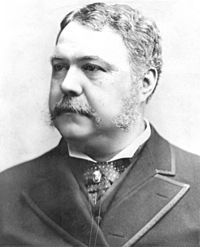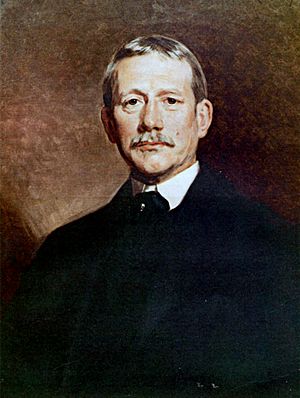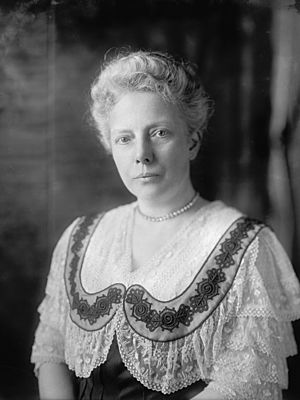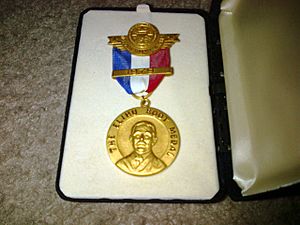Elihu Root facts for kids
Quick facts for kids
Elihu Root
|
|
|---|---|

Root in 1902
|
|
| 38th United States Secretary of State | |
| In office July 19, 1905 – January 27, 1909 |
|
| President | Theodore Roosevelt |
| Preceded by | John Hay |
| Succeeded by | Robert Bacon |
| 41st United States Secretary of War | |
| In office August 1, 1899 – January 31, 1904 |
|
| President | |
| Preceded by | Russell A. Alger |
| Succeeded by | William Howard Taft |
| United States Senator from New York |
|
| In office March 4, 1909 – March 3, 1915 |
|
| Preceded by | Thomas C. Platt |
| Succeeded by | James Wadsworth |
| United States Attorney for the Southern District of New York | |
| In office March 12, 1883 – July 6, 1885 |
|
| President | Chester A. Arthur Grover Cleveland |
| Preceded by | Stewart L. Woodford |
| Succeeded by | William Dorsheimer |
| Personal details | |
| Born | February 15, 1845 Clinton, New York |
| Died | February 7, 1937 (aged 91) New York City |
| Political party | Republican |
| Spouse | Clara Wales |
| Relations | Oren Root II (brother) |
| Education | Hamilton College (BA, MA) New York University (LLB) |
| Signature | |
Elihu Root (February 15, 1845 – February 7, 1937) was an important American lawyer and politician. He was a member of the Republican Party. Root served as the 41st U.S. Secretary of War and the 38th U.S. Secretary of State. He also represented New York as a U.S. Senator. In 1912, he won the Nobel Peace Prize for his efforts to promote peace.
Elihu Root was a top lawyer in New York City. He often moved between important government jobs in Washington, D.C., and his private law practice. He worked for big companies and powerful people like Andrew Carnegie. Root also led groups like the Carnegie Endowment for International Peace. He believed that only men should vote and worked to keep this rule in New York.
As Secretary of War from 1899 to 1904, Root managed new lands the U.S. gained after the Spanish–American War. These included the Philippines and Cuba. He wanted to help these areas develop with new technology and good public service. He helped create important laws for these territories. Root also strongly supported building the Panama Canal and the Open Door Policy. He made the U.S. Army more modern and professional. He improved the National Guard and started the United States Army War College.
After a short break, Root became Secretary of State from 1905 to 1909. He improved the way the government's foreign offices worked. He also helped build good relationships with countries in Latin America. Root solved problems with Japan about workers coming to the West Coast of the United States. He arranged 24 treaties to settle international disagreements peacefully. This work helped create the Permanent Court of International Justice.
As a U.S. Senator, Root supported President William Howard Taft. He helped Taft get nominated for a second term in 1912. By 1916, Root believed the U.S. should prepare for World War I. President Woodrow Wilson sent him to Russia in 1917. Root hoped to make an alliance with Russia's new government. He supported Wilson's idea for the League of Nations.
Contents
Elihu Root's Early Life and Education
Elihu Root was born in Clinton, New York. His parents were Oren Root and Nancy Whitney Buttrick. His father was a math professor at Hamilton College.
Elihu went to local schools, including Williston Seminary. He then attended Hamilton College. He joined student groups like the Sigma Phi Society. After college, Root taught physical education and history for a few years.
Root's parents wanted him to become a minister. But Elihu moved to New York City in 1865 to study law. He went to New York University School of Law. He also taught American history to earn money. Root studied law for two years, which was longer than most students at the time. He graduated in 1867 and became a lawyer.
Elihu Root's Legal Career
After becoming a lawyer, Root worked for a top law firm in New York City. In 1868, he started his own firm with other young lawyers. He had different partners over the years. His firm eventually became Pillsbury Winthrop Shaw Pittman.
Root's early work was simple. But his career grew quickly after he met John J. Donaldson, a bank president. Donaldson was impressed with Root's skills. He hired Root for personal matters and small cases for the bank. Root's public image grew when he defended William M. Tweed. Tweed was a powerful political leader in New York.
In 1881, Root was allowed to practice law before the Supreme Court of the United States. In 1883, President Chester A. Arthur made him the U.S. Attorney for the Southern District of New York. This meant he was the main government lawyer in New York City. In this role, Root handled important cases.
Root worked for many rich and famous clients. These included Jay Gould and Andrew Carnegie. He also advised political leaders. After 1899, Root focused on his public service. He later returned to law in an advisory role. He also became the president of the American Bar Association.
Working as U.S. Attorney (1883–1885)

Early in his career, Root avoided politics. He thought it would hurt his law career. But he became active in the Republican Party in his neighborhood. He also joined the Union League Club. Through the club, Root met Chester A. Arthur. Arthur later became Vice President and then President.
In 1881, Root also met Theodore Roosevelt. Roosevelt was elected to the State Assembly from Root's area. Root supported Roosevelt's career. He helped Roosevelt get nominated for office.
President Arthur appointed Root as the United States Attorney for the Southern District of New York in March 1883. This was a part-time job. Root spent his mornings on government work and his afternoons on his private law practice. Many of his cases involved customs duties.
International Law Cases
As U.S. Attorney, Root first worked with international law. This became a big part of his later career. He handled cases about ships helping rebels in other countries. He also defended the government in cases about immigration laws. The government won these cases in the Supreme Court.
Important Prosecutions
One of Root's most famous cases was the prosecution of James C. Fish. Fish was involved in a large fraud scheme. This scheme caused a financial crisis in 1884. Root worked hard on the case for six weeks. He even took a statement from former President Ulysses S. Grant. The jury found Fish guilty.
The press praised Root for his work on the Fish case. They said he was skilled and professional. He was also credited with clearing the name of the late President Grant. Root resigned in July 1885. He later helped with other prosecutions related to the fraud.
Secretary of War (1899–1904)
In July 1899, President William McKinley asked Root to be his Secretary of War. This was after the Spanish–American War. The war was a success, but the previous Secretary had problems. Root first said no, but then accepted. He realized McKinley wanted a lawyer to help govern the new territories.
As Secretary of War, Root helped set up civilian governments. This was for the new American territories of Cuba, the Philippines, and Puerto Rico. He also made the Department of War more modern.
Root left the cabinet in 1904. He returned to his private law practice. William Howard Taft took over his role.
Military Improvements

When Root became Secretary of War, the department was known for being inefficient. Root's main goal was to improve how the military was run. He believed this was key for managing the new territories. He worked with other military leaders to make changes.
He improved the way the Department of War was organized. He made the United States Military Academy larger. He also created the U.S. Army War College and a General Staff. He changed how officers were promoted. He also started schools for different military branches.
Governing New Territories
After the Spanish–American War, the U.S. controlled Cuba, the Philippines, and Puerto Rico. Root was in charge of managing these islands. He had to help them move from military rule to civilian government. The U.S. had promised to give Cuba back to its people. In the Philippines, the U.S. faced fighting from local groups.
Root worked with legal advisors on this task. He created plans for Cuba to become independent. He also helped set up a government for the Philippines. He removed taxes on goods coming from Puerto Rico to the U.S. When some groups criticized U.S. policies in the Philippines, Root defended them. He argued that critics made the fighting last longer.
Secretary of State (1905–1909)
In 1905, President Roosevelt made Root the United States Secretary of State. This happened after the death of John Hay. As Secretary, Root improved the foreign service. He made sure people were hired based on skill, not favors. He continued the Open Door Policy in Asia. This policy aimed to keep trade open for all countries in China.
In 1906, Root visited Latin America. He convinced countries there to join the Hague Peace Conference. He worked with Japan to limit immigration to the U.S. He also dealt with issues involving China. He helped create the Root–Takahira Agreement. This agreement limited naval bases for Japan and the U.S. in the Pacific. He also worked with Great Britain to settle disputes with Canada. These included border issues in Alaska and fishing rights. Root strongly supported using arbitration to solve international problems.
United States Senator (1909–1915)
In January 1909, Root was elected as a U.S. Senator from New York. He served from March 4, 1909, to March 3, 1915. He was part of the Senate Committee on the Judiciary. He decided not to run for re-election in 1914.
During and after his time as Senator, Root led the Carnegie Endowment for International Peace. He was president from 1910 to 1925.
In 1912, Root received the Nobel Peace Prize. This was for his work in bringing nations together through peaceful talks and cooperation.
World War I
At the start of World War I in 1914, Root believed the U.S. should not be neutral. He supported the Preparedness Movement. This movement aimed to get the United States ready to join the war. He strongly believed the U.S. should fight with Britain and France. He worried that Germany's military power would be bad for the world.
In June 1916, people thought he might run for president. But Root said he was too old. At the Republican convention, he received many votes. But the nomination went to Charles Evans Hughes. Hughes lost the election to Woodrow Wilson.
Root Commission to Russia
In June 1917, when he was 72, Root led a special group to Russia. President Wilson sent them to work with Russia's new government. Root stayed in Petrograd for almost a month. He was not impressed by what he saw. He said the Russian people were "sincere, kindly, good people but confused and dazed." He believed the U.S. could only give money to Russia if they kept fighting in the war. This led to failed attacks by the Russian government. This also helped the Bolshevik party take power later that year.
Root was the first chairman of the Council on Foreign Relations. This group was started in 1918 in New York.
Later Career
In 1919, there was a big debate in the Senate about the U.S. joining the League of Nations. Root supported joining, but with certain conditions. These conditions would allow the U.S. government to decide if it would go to war. The United States never joined the League. However, Root still supported it. He helped create the Permanent Court of International Justice. In 1922, President Warren G. Harding appointed Root as a delegate to the Washington Naval Conference. Root was 77 at the time. He also voted for Calvin Coolidge in the 1924 presidential election.
Root also worked with Andrew Carnegie on projects for international peace and science. He became the first president of the Carnegie Endowment for International Peace. Root also helped start the American Law Institute in 1923. He helped create The Hague Academy of International Law in the Netherlands. Root was also a vice president of the American Peace Society.
Elihu Root's Views
Against Women's Right to Vote
Elihu Root was a well-known opponent of women's suffrage. This means he was against women having the right to vote. In 1894, he spoke against women voting at a meeting in New York. He worked to make sure the state constitution only allowed men to vote. He continued to oppose feminism throughout his life. In 1917, he became president of a group that was against women's right to vote.
Personal Life
Family
In 1870, Root traveled to Europe with his brother Wally. Wally was very sick with tuberculosis. Elihu took care of him during the trip. Wally died in November 1870.
In 1878, Root married Clara Frances Wales. She was the daughter of a well-known New York politician. They had three children:
- Edith Root (born 1878)
- Elihu Root Jr. (born 1881)
- Edward Wales Root (born 1884)
Elihu Root Jr. also became a lawyer, like his father.
Religion
Root was a strong Presbyterian. This was the religion he grew up with. When he first moved to New York City, he joined the Young Men's Christian Association. He was a vice president there. He also taught Sunday school.
Friends and Groups
Chief Judge Willard Bartlett was Root's lifelong friend. They met as young lawyers. Root also enjoyed hunting big game with President Roosevelt.
Root was a member of the Union League Club of New York. He was president of the club twice. He also led the New York City Bar Association. In 1917, he became president of the National Security League. As head of this group, Root spoke in favor of war. He also continued to speak against women's right to vote.
Death and Legacy
Elihu Root passed away in 1937 in New York City. He was buried next to his wife, Clara, at the Hamilton College Cemetery.
Root was the last living member of President McKinley's cabinet. He was also the last cabinet member to have served in the 1800s.
Legacy
Some historians say Root was the first "foreign policy grandmaster" in American history. They believe he helped make America a world power more than anyone else. Root worked to make sure the U.S. was always involved in world affairs. He also helped build a special relationship between the United States and Great Britain. Root helped powerful business leaders and smart thinkers support an active role for the U.S. in the world.
Besides the Nobel Prize, Root received other honors. These included awards from Belgium and Greece.
Memorials
During World War II, a Liberty ship called SS Elihu Root was built and named after him.
Root's home in Clinton, New York, is now known as the Elihu Root House. It was named a National Historic Landmark in 1972. A U.S. Army Reserve Base in New York Mills, New York, is also named after him.
The Elihu Root Gold Medal is given to top civilian shooters in a rifle competition. The best team's captain and coach also receive these medals.
Works by Elihu Root
Articles
- “A Requisite for the Success of Popular Diplomacy”. Foreign Affairs, 1922.
- "Statesman and Useful Citizen" Vanity Fair, 1915
Books
- The Citizen's Part in Government. Yale University Press, 1911.
- Experiments in Government and the Essentials of the Constitution. Princeton University Press, 1913.
- Addresses on International Subjects. Harvard University Press, 1916.
- The Military and Colonial Policy of the United States: Addresses and Reports by Elihu Root. Harvard University Press, 1916.
- Miscellaneous Addresses. Harvard University Press, 1917.
- Men and Policies: Addresses by Elihu Root. Harvard University Press, 1925.
Published Addresses
- “Theodore Roosevelt”. The North American Review, November 1919.
- The Short Ballot and the “Invisible Government”: An Address by Elihu Root. New York: The National Short Ballot Organization, 1919.
See also
 In Spanish: Elihu Root para niños
In Spanish: Elihu Root para niños
- List of people on the cover of Time magazine (1920s): October 18, 1926




